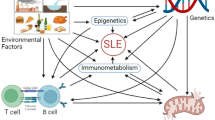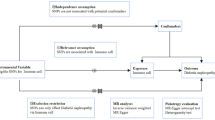Abstract
Rheumatoid arthritis (RA) is a crucial inflammatory joint disease characterized by loss of self-tolerance and severe cartilage loss, autoimmune, and subchondral bone erosions. Cytokines are the key regulators of inflammatory responses. Homeostatic imbalances in pro- and anti-inflammatory cytokine activities can result in pathogenic inflammatory reactions. These imbalances could be initiated by environmental factors but the ability to define the threshold of environmental impact relies on the genetic background of the pro- and anti-inflammatory cytokines. To address this a case-control association study was carried out in 429 individuals from Malayalam speaking ethnic population from South India. Functionally relevant SNPs from IL-10, IL-6, IL-1β and IL-1RN were genotyped using PCR -RFLP and sequencing. Meta-analysis was performed for the associated variants of IL-10, IL-1β. Significant association with RA was observed with IL-1β rs1143634, rs1143627, IL-10 rs1800896, IL-6 rs1800796, rs1800797. The associated SNPs are likely to impact transcriptional activity of a gene. Meta-analysis with global populations also provide evidence that IL-10 and IL-1β could be a global marker for RA. The functional significance of associated risk variants of IL-1β and IL-6 indicate increased production of the pro-inflammatory cytokines while IL-10 risk allele suggest reduced production of anti- inflammatory cytokines. The study concludes that increased production of pro-inflammatory cytokines and reduced production of anti- inflammatory cytokines may influence the Th1/Th2 equilibrium resulting in a triggering of Th1 mediated inflammatory responses in development of RA.



Similar content being viewed by others
References
Scott DL, Wolfe F, Huizinga TW (2010) Rheumatoid arthritis. Lancet 376:1094–1108
Malaviya AN, Kapoor SK, Singh RR et al (1993) Prevalence of rheumatoid arthritis in the adult Indian population. Rheumatol Int 13(4):131–134
Jung SM, Kim KW, Yang CW et al (2014) Cytokine-mediated bone destruction in rheumatoid arthritis. J Immunol Res. 2014:263625
Nepom GT (1998) Major histocompatibility complex-directed susceptibility to rheumatoid arthritis. Adv Immunol 68:315–332
Dedmon LE (2020) The genetics of rheumatoid arthritis. Rheumatology 59(10):2661–2670
Mikhaylenko DS, Nemtsova MV, Bure IV et al (2020) Genetic polymorphisms associated with rheumatoid arthritis development and antirheumatic therapy response. Int J Mol Sci 21(14):4911
Walker JG, Littlejohn GO et al (1999) Stress system response and rheumatoid arthritis: a multilevel approach. Rheumatology 38(11):1050–1057
Overwijk WW, Schluns KS (2009) Functions of γ Ccytokines in immune homeostasis: current and potential clinical applications. Clin Immunol 132(2):153–165
Kaiko GE, Horvat JC, Beagley KW et al (2008) Immunological decision-making: how does the immune system decide to mount a helper T-cell response? Immunology 123(3):326–338
Choy EH, Panayi GS (2001) Cytokine pathways and joint inflammation in rheumatoid arthritis. N Engl J Med 344(12):907–916
Boissier MC (2011) Cell and cytokine imbalances in rheumatoid synovitis. Joint Bone Spine 78(3):230–234
Ollier WE (2004) Cytokine genes and disease susceptibility. Cytokine 28(4–5):174–178
Ying B, Shi Y, Pan X et al (2011) Association of polymorphisms in the human IL-10 and IL-18 genes with rheumatoid arthritis. Mol Biol Rep 38(1):379–385
Thomas R, Nair SB, Banerjee M (2006) A crypto-Dravidian origin for the nontribal communities of South India based on human leukocyte antigen class I diversity. Tissue Antigens 68:225–234
Saradalekshmi KR, Neetha NV, Sathyan S et al (2014) DNA methyl transferase (DNMT) gene polymorphisms could be a primary event in epigenetic susceptibility to schizophrenia. PLoS ONE 9(5):e98182
Sambrook J, RussellRussell DW, Sathyan S (2006) Purification of nucleic acids by extraction with phenol: chloroform. CSH Protoc 2006(1):pdb.prot4455
Srinivas L, Vellichirammal NN, Alex AM et al (2016) Pro-inflammatory cytokines and their epistatic interactions in genetic susceptibility to schizophrenia. J Neuroinflamm 13:105
Mateen S, Zafar A, Moin S et al (2016) Understanding the role of cytokines in the pathogenesis of rheumatoid arthritis. Clin Chim Acta 455:161–171
Barrera P, Faure S, Prud homme JF et al (2001) European genetic study on rheumatoid arthritis: is there a linkage of the interleukin-1 (IL-1), IL-10, or IL-4 genes to RA? Clin Exp Rheumatol 19(6):709–714
Arman A, Yilmaz B, Coker A et al (2006) Interleukin-1 receptor antagonist (IL-1RN) and interleukin-1B gene polymorphisms in Turkish patients with rheumatoid arthritis. Clin Exp Rheumatol 24(6):643–648
Kobayashi T, Ito S, Kuroda T et al (2007) The interleukin-1 and Fcγ receptor gene polymorphisms in Japanese patients with rheumatoid arthritis and periodontitis. J Periodontol 78(12):2311–2318
You CG, Li JF, Xie XD et al (2007) Association of interleukin-1 genetic polymorphisms with the risk of rheumatoid arthritis in Chinese population. Clin Chem Lab Med 45(8):968–971
Huang CM, Tsai FJ et al (2001) Interleukin-1beta and interleukin-1receptor antagonist gene polymorphism in rheumatoid arthritis. Scand J Rheumatol 30(4):225–228
Camargo JF, Correa PA, Castiblanco J, Anaya JM (2004) Interleukin-1 β polymorphisms in Colombian patients with autoimmune rheumatic diseases. Genes Immun 5(8):609–614
Pawlik A, Kurzawski M, Florczak M et al (2005) IL1beta+ 3953 exon 5 and IL-2-330 promoter polymorphisms in patients with rheumatoid arthritis. Clin Exp Rheumatol 23(2):159–164
You CG, Li XJ, Li YM et al (2013) Association analysis of single nucleotide polymorphisms of proinflammatory cytokine and their receptors genes with rheumatoid arthritis in northwest Chinese Han population. Cytokine 61(1):133–138
Shafia S, Dilafroze Sofi FA, Rasool R et al (2014) Rheumatoid arthritis and genetic variations in cytokine genes: a population-based study in Kashmir Valley. Immunol Invest 43(4):349–359
Cantagrel A, Navaux F, Loubet-Lescoulié P et al (1999) Interleukin-1β, interleukin-1 receptor antagonist, interleukin-4, and interleukin-10 gene polymorphisms: relationship to occurrence and severity of rheumatoid arthritis. Arthritis Rheum 42(6):1093–1100
Kaijzel EL, Van Dongen H, Bakker AM et al (2002) Relationship of polymorphisms of the interleukin-1 gene cluster to occurrence and severity of rheumatoid arthritis. Tissue Antigens 59(2):122–126
Genevay S, Di Giovine FS, Perneger TV et al (2002) Association of interleukin-4 and interleukin-1B gene variants with Larsen score progression in rheumatoid arthritis. Arthritis Rheum 47(3):303–309
Tolusso B, Pietrapertosa D, Morelli A et al (2006) IL-1B and IL-1RN gene polymorphisms in rheumatoid arthritis: relationship with protein plasma levels and response to therapy. Pharmacogenomics 7(5):683–695
Lubbe S, Tikly M, van der Merwe L et al (2008) Interleukin-1 receptor antagonist gene polymorphisms are associated with disease severity in Black South Africans with rheumatoid arthritis. Joint Bone Spine. 75:422–425
Allam I, Djidjik R, Ouikhlef N et al (2013) Interleukin-1 and the interleukin-1 receptor antagonist gene polymorphisms study in patients with rheumatoid arthritis. Pathologie-Biologie 61(6):264–268
Hall SK, Perregaux DG, Gabel CA et al (2004) Correlation of polymorphic variation in the promoter region of interleukin-1beta gene with secretion of interleukin-1 beta protein. Arthritis Rheum 50(6):1976–1983
Johnsen AK, Plenge RM, Butty V et al (2008) A broad analysis of IL1 polymorphism and rheumatoid arthritis. Arthritis Rheum 58(7):1947–1957
Emonts M, Hazes MJ, Houwing-Duistermaat JJ et al (2011) Polymorphisms in genes controlling inflammation and tissue repair in rheumatoid arthritis: a case control study. BMC Med Genet 12(1):36
Dai D, Wang L, Xu L et al (2014) A comprehensive meta-analysis of the association between three IL1B polymorphisms and rheumatoid arthritis. Adv Biosci Biotechnol 5(2):108–116. https://doi.org/10.4236/abb.2014.52015
Pociot F, Mølvig J, Wogensen L et al (1992) A Taql polymorphism in the human interleukin-1β gene correlates with IL-1β secretion in vitro. Eur J Clin Investig 22(6):396–402
Guasch JF, Bertina RM, Reitsma PH (1996) Five novel intragenic dimorphisms in the human interleukin–1 genes combine to high informativity. Cytokine 8(8):598–602
Buchs N, di Giovine FS, Silvestri T, Vannier E, Duff GW, Miossec P (2001) IL-1B and IL-1Ra gene polymorphisms and disease severity in rheumatoid arthritis: interaction with their plasma levels. Genes Immun 2(4):222–228
Hutchins AP, Diez D, Miranda-Saavedra D (2013) The IL-10/STAT3-mediated anti-inflammatory response: recent developments and future challenges. Briefings Funct Genomics 12(6):489–498
Marinou I, Healy J, Mewar D et al (2007) Association of interleukin-6 and interleukin-10 genotypes with radiographic damage in rheumatoid arthritis is dependent on autoantibody status. Arthritis Rheum 56(8):2549–2556
Gambhir D, Lawrence A, Aggarwal A et al (2010) Association of tumor necrosis factor alpha and IL-10 promoter polymorphisms with rheumatoid arthritis in North Indian population. Rheumatol Int 30(9):1211–1217
Moreno OM, González CI, Saaibi DL et al (2007) Polymorphisms of IL-10 gene promoter and rheumatoid arthritis in a Colombian population. Biomedica 27(1):56–65
Martinez A, Pascual M, Pascual-Salcedo D et al (2003) Genetic polymorphisms in Spanish rheumatoid arthritis patients: an association and linkage study. Genes Immun 4(2):117–121
Hee CS, Gun SC, Naidu R et al (2007) Comparison of single nucleotide polymorphisms in the human interleukin-10 gene promoter between rheumatoid arthritis patients and normal subjects in Malaysia. Mod Rheumatol 17(5):429–435
Katsikis PD, Chu CQ, Brennan FM et al (1994) Immunoregulatory role of interleukin 10 in rheumatoid arthritis. J Exp Med 179(5):1517–1527
Huizinga TWJ, Keijsers V, Yanni G et al (2000) Are differences in interleukin 10 production associated with joint damage? Rheumatology 39(11):1180–1188
Fishman D, Faulds G, Jeffery R et al (1998) The effect of novel polymorphisms in the interleukin-6 (IL-6) gene on IL-6 transcription and plasma IL-6 levels, and an association with systemic-onset juvenile chronic arthritis. J Clin Investig 102(7):1369–1376
Huang XZ, Zhuang JH, Ren YG et al (2007) Association of interleukin-6 and interleukin-18 gene polymorphism with rheumatoid arthritis in Guangdong Han population. J Southern Med Univ 27(11):1661–1664
Li F, Xu J, Zheng J et al (2014) Association between interleukin-6 gene polymorphisms and rheumatoid arthritis in Chinese Han population: a case-control study and a meta-analysis. Sci Rep 4:5714
Arman A, Coker A, Sarioz O et al (2012) Lack of association between IL-6 gene polymorphisms and rheumatoid arthritis in Turkish population. Rheumatol Int 32(7):2199–2201
Ferrari SL, Ahn-Luong L, Garnero P et al (2003) Two promoter polymorphisms regulating interleukin-6 gene expression are associated with circulating levels of C-reactive protein and markers of bone resorption in postmenopausal women. J Clin Endocrinol Metab 88(1):255–259
Malemud CJ, Pearlman E (2009) Targeting JAK/STAT signaling pathway in inflammatory diseases. Curr Signal Transduct Res 4:201–221
Deon D, Ahmed S, Tai K et al (2001) Cross-talk between IL-1 and IL-6 signaling pathways in rheumatoid arthritis synovial fibroblasts. J Immunol. 167(9):5395–5403
Isomäki P, Junttila I, Vidqvist KL, Korpela M, Silvennoinen O (2015) The activity of JAK-STAT pathways in rheumatoid arthritis: constitutive activation of STAT3 correlates with interleukin 6 levels. Rheumatology 54(6):1103–1113
Ortiz MA, Diaz-Torné C, Hernández MV et al (2015) IL-6 blockade reverses the abnormal STAT activation of peripheral blood leukocytes from rheumatoid arthritis patients. Clin Immunol. 158(2):174–182
Acknowledgements
KP acknowledges Indian Council for Medical Research (ICMR), Government of India, for providing Senior Research Fellowship and Human Molecular Genetics Laboratory, Rajiv Gandhi Center for Biotechnology for providing a collaborative research platform and KIMS Hospital for patient’s sample collection to carry out the molecular work.
Author information
Authors and Affiliations
Corresponding author
Ethics declarations
Conflict of interest
The authors declare that they have no competing interests.
Additional information
Publisher's Note
Springer Nature remains neutral with regard to jurisdictional claims in published maps and institutional affiliations.
Electronic supplementary material
Below is the link to the electronic supplementary material.
Rights and permissions
About this article
Cite this article
Krishna Priya, E.K., Srinivas, L., Rajesh, S. et al. Pro-inflammatory cytokine response pre-dominates immuno-genetic pathway in development of rheumatoid arthritis. Mol Biol Rep 47, 8669–8677 (2020). https://doi.org/10.1007/s11033-020-05909-2
Received:
Accepted:
Published:
Issue Date:
DOI: https://doi.org/10.1007/s11033-020-05909-2




